There’s something undeniably charming about farmhouse style that has captured the hearts of homeowners and designers alike. This beloved aesthetic blends rustic elements with modern comforts to create spaces that feel both timeless and inviting. Whether you’re looking to completely transform your home or simply add a few farmhouse touches, this guide will walk you through everything you need to know about embracing this warm and functional design approach.
The Origins and Core Principles of Farmhouse Style
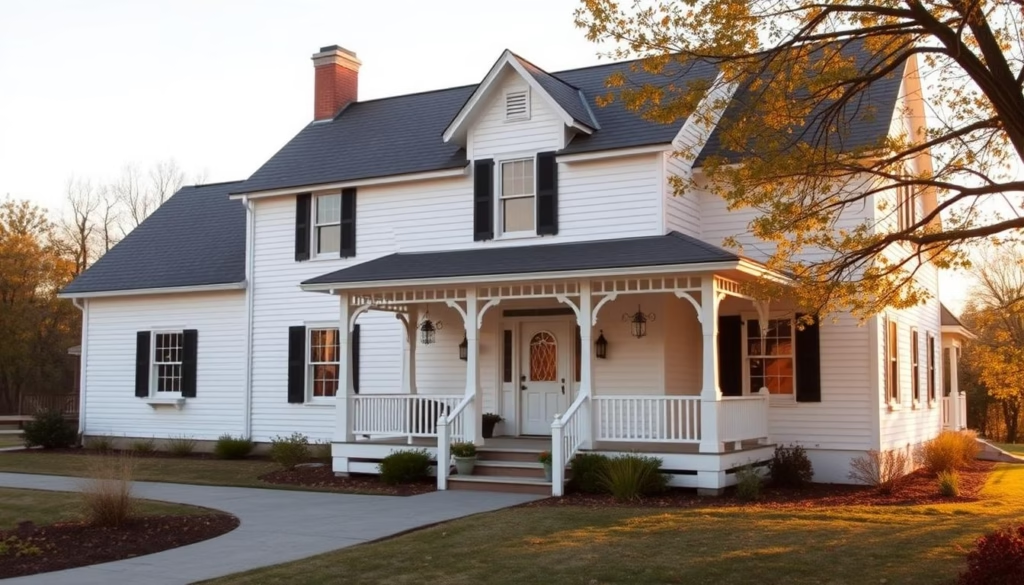
The classic farmhouse exterior embodies simplicity and functionality
Farmhouse style traces its roots back to early American settlers who built practical, no-frills homes focused on functionality. These original farmhouses were constructed with locally available materials and designed to withstand the demands of rural life. The aesthetic wasn’t a conscious style choice but rather a reflection of necessity and practicality.
At its core, farmhouse style embraces three fundamental principles:Simplicity: Clean lines, uncluttered spaces, and straightforward design that prioritizes function over fussy details.Functionality: Every element serves a purpose, with an emphasis on practical, hardworking spaces and furnishings.Rustic Charm: Natural materials, handcrafted elements, and a lived-in quality that feels authentic rather than perfect.
What began as a purely utilitarian approach has evolved into a deliberate aesthetic that honors these traditional values while incorporating contemporary elements. Today’s farmhouse style strikes a beautiful balance between old and new, creating spaces that feel both nostalgic and fresh.
Key Elements of Farmhouse Style
Understanding the essential components of farmhouse style will help you incorporate this aesthetic into your own home with confidence. Let’s explore the building blocks that create that distinctive farmhouse feel.
Neutral Color Palettes
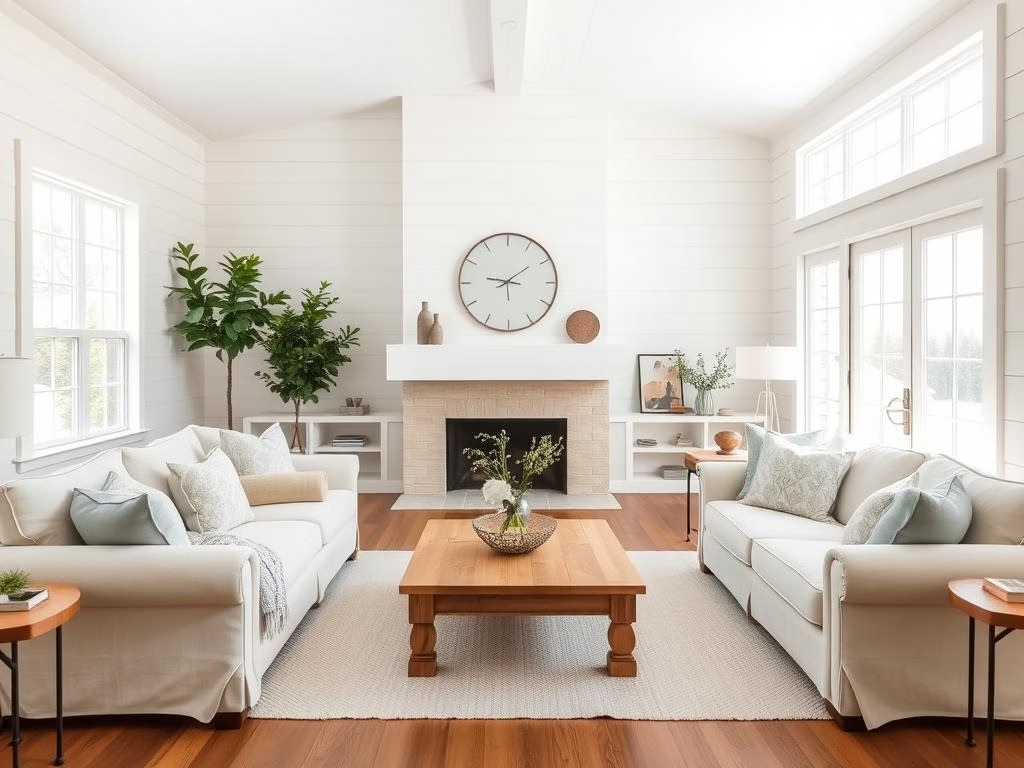
Neutral colors create a calm, timeless backdrop for farmhouse interiors
The farmhouse color palette centers around soothing neutrals that create a sense of calm and timelessness. White is the quintessential farmhouse color, serving as a clean backdrop that highlights architectural details and allows other elements to shine.Whites and Creams: From crisp whites to warm ivory, these light neutrals form the foundation of farmhouse interiors.Soft Grays: Light to medium gray tones add subtle contrast without overwhelming the space.Muted Earth Tones: Gentle beiges, taupes, and wheat colors bring warmth and connection to nature.Accent Colors: Soft blues, sage greens, and dusty reds can be incorporated as subtle accents that complement the neutral base.
Natural Materials
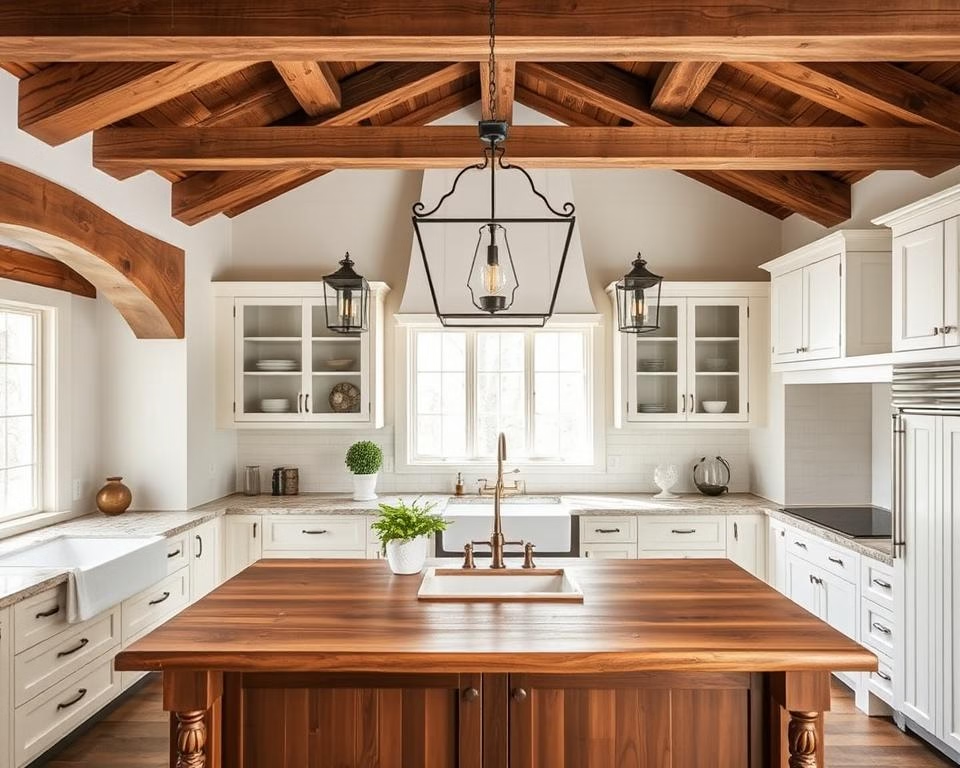
Natural materials add texture and authenticity to farmhouse spaces
Authentic materials that showcase their natural beauty are essential to farmhouse style. These elements bring texture, warmth, and a connection to the outdoors.
Wood
Wood is perhaps the most important material in farmhouse design. Look for:Reclaimed barn wood for accent walls or furnitureWide-plank hardwood flooring with visible grainExposed ceiling beams, whether structural or decorativeRaw or lightly finished wood furniture with visible knots and character
Other Key Materials
Stone: Natural stone countertops, fireplaces, or flooringMetal: Wrought iron fixtures, galvanized steel, and aged brassLinen and Cotton: Natural fiber textiles for upholstery and window treatmentsCeramic: Handmade pottery, subway tile, and farmhouse sinks
Ready to transform your space?
Get our free guide with 25 farmhouse style ideas you can implement this weekend!
Vintage and Distressed Furniture
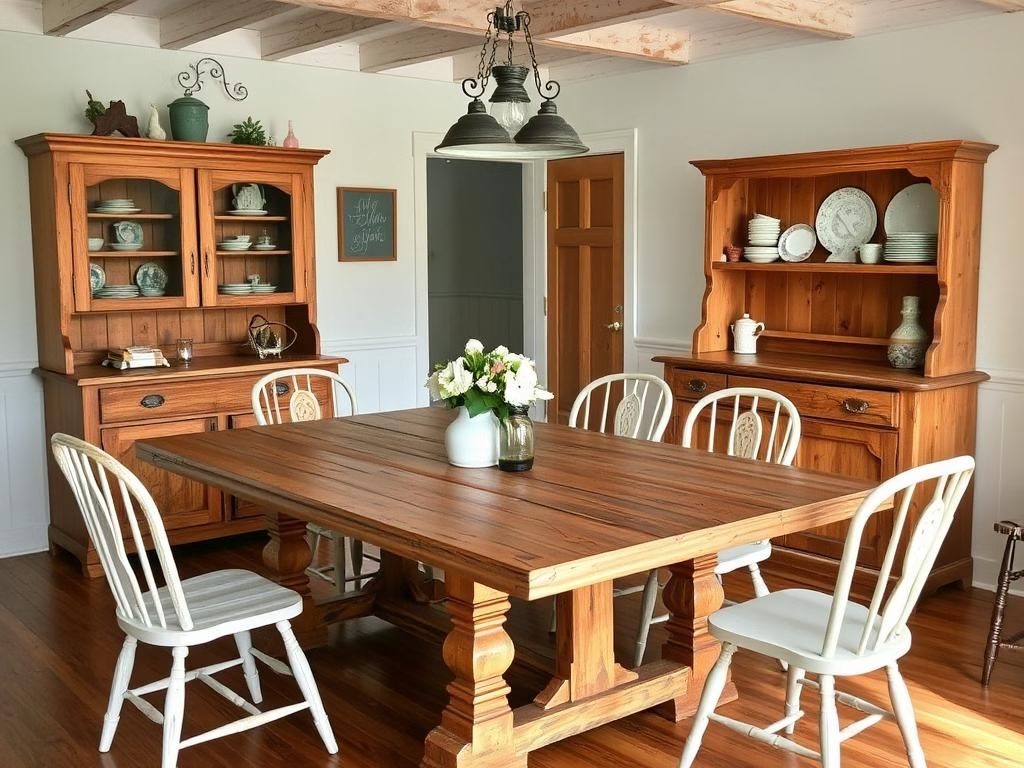
Vintage pieces add character and history to farmhouse interiors
Farmhouse style embraces furniture with history and character. Pieces that show signs of age and use contribute to the authentic, lived-in feel that makes this aesthetic so appealing.Antique Finds: Incorporate genuine vintage pieces like hutches, dressers, or side tables that tell a story.Distressed Finishes: Look for furniture with worn edges, chipped paint, or patina that suggests years of use.Mixed and Matched: Don’t be afraid to combine different wood tones and styles for an evolved-over-time look.Repurposed Items: Old ladders as blanket racks, vintage crates as storage, or antique doors as headboards add unique character.
Cozy Textiles
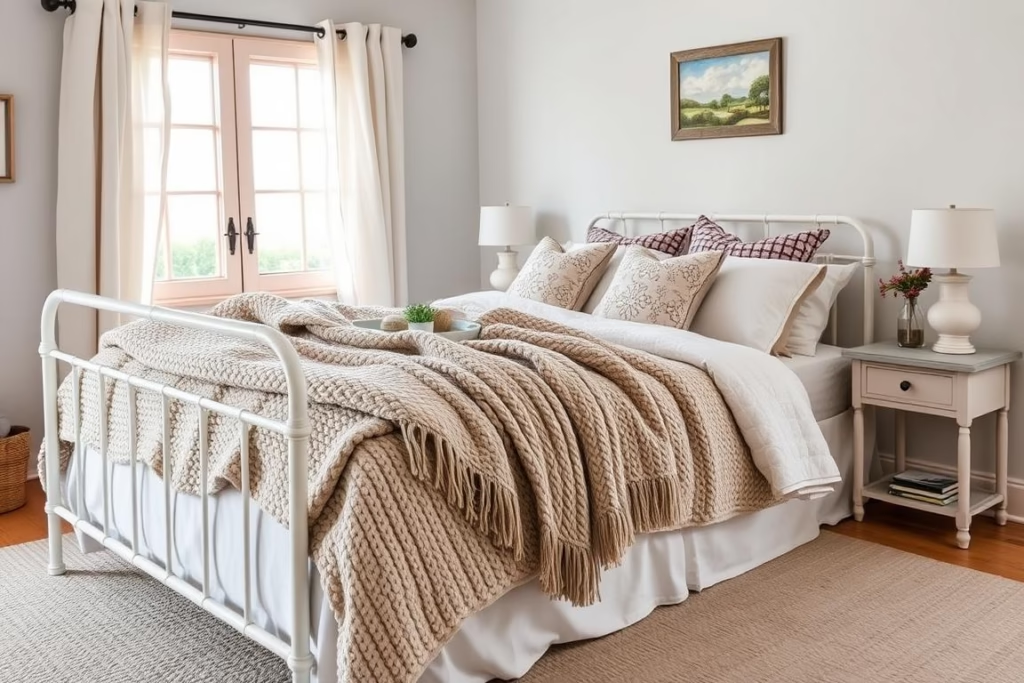
Layered textiles add warmth and comfort to farmhouse bedrooms
Soft, tactile textiles are essential for creating the cozy, inviting atmosphere that farmhouse style is known for. These elements add warmth, texture, and comfort to every room.Quilts and Coverlets: Handmade or vintage-inspired quilts add pattern and a sense of heritage.Chunky Knit Throws: Drape these over sofas or chairs for instant warmth and texture.Linen Upholstery: Slipcovers in natural linen create a relaxed, casual feel.Grain Sack Fabrics: Pillows or upholstery in traditional grain sack patterns add authentic vintage charm.Simple Window Treatments: Unlined linen curtains that filter light beautifully or simple roman shades.
Decorative Accents
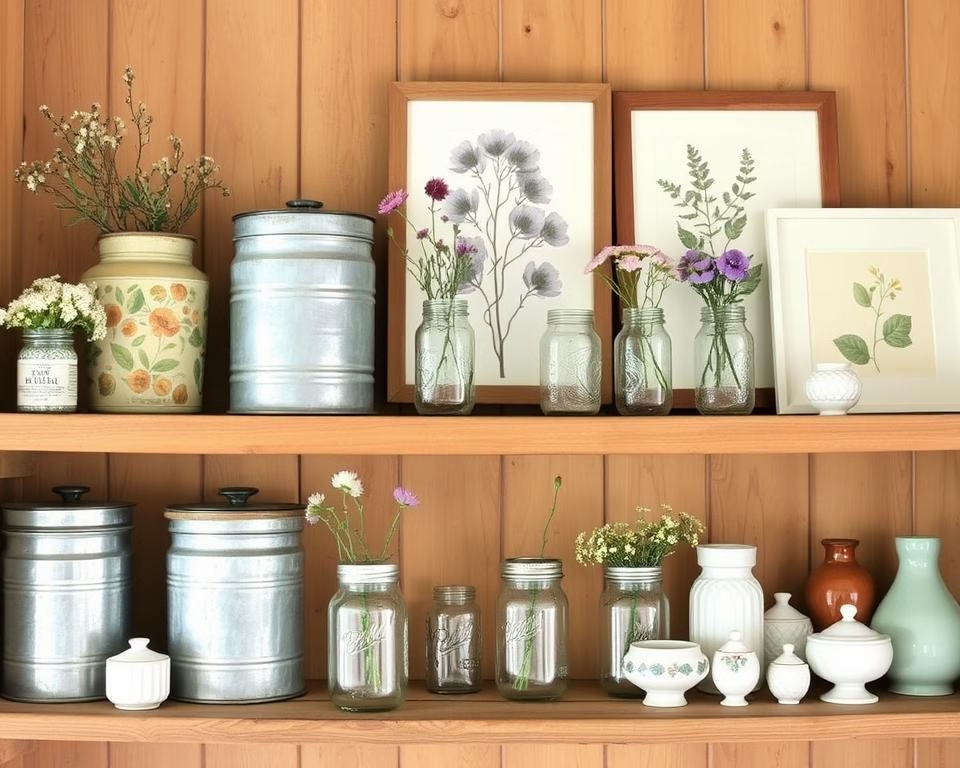
Thoughtfully chosen accents complete the farmhouse look
The finishing touches in farmhouse style tend to be simple, purposeful, and often reference agricultural or rural life. These accents should feel collected over time rather than purchased as a matching set.Galvanized Metal: Buckets, watering cans, and trays add industrial charm.Mason Jars: Use as vases, storage, or light fixtures for classic farmhouse appeal.Botanical Prints: Framed herb or flower illustrations bring a touch of nature indoors.Vintage Signs: Old advertising signs or farm-related signage add character.Natural Elements: Woven baskets, wooden bowls, and fresh or dried flowers.Simple Ceramics: Stoneware in neutral colors with minimal decoration.
Modern Farmhouse: A Contemporary Twist
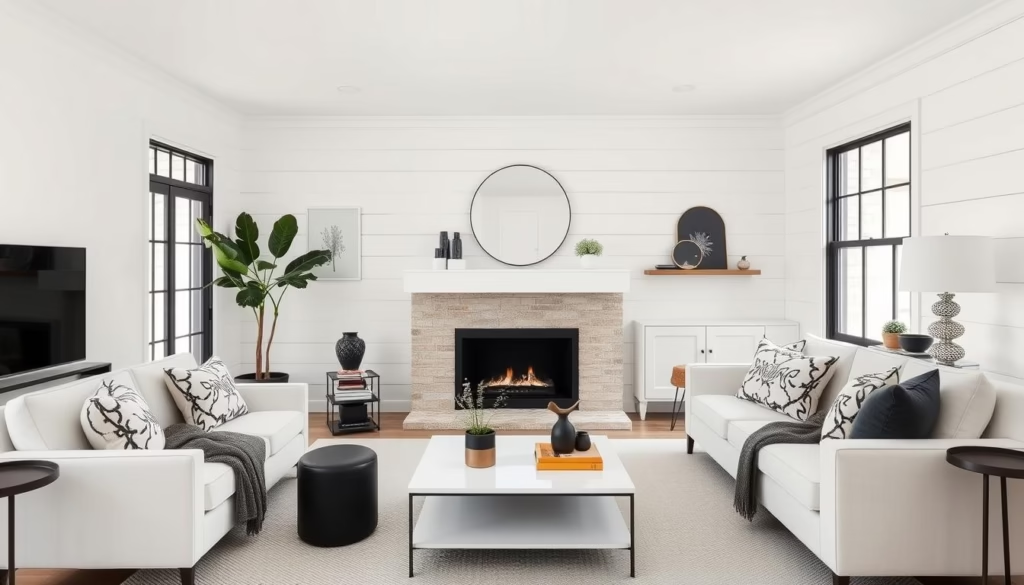
Modern farmhouse style combines traditional elements with contemporary design
While traditional farmhouse style leans heavily on vintage elements and rustic details, modern farmhouse introduces cleaner lines and contemporary touches. This popular variation maintains the warmth and character of classic farmhouse while feeling fresh and current.Higher Contrast: Modern farmhouse often incorporates black accents against white backgrounds for dramatic effect.Cleaner Lines: Furniture and architectural details tend to be less ornate and more streamlined.Selective Rustic Elements: Rather than going all-in on distressed finishes, modern farmhouse carefully chooses where to incorporate rustic touches.Updated Materials: Concrete countertops, matte black fixtures, and industrial elements add contemporary edge.Minimal Decor: Less cluttered with a more curated approach to accessories and collections.
The modern farmhouse approach offers flexibility for those who appreciate farmhouse warmth but prefer a more contemporary aesthetic. It’s particularly well-suited to newer homes where adding too many rustic elements might feel forced or inauthentic.
Practical Tips for Incorporating Farmhouse Style
Ready to bring farmhouse style into your own home? Here are actionable tips to help you implement this aesthetic, whether you’re planning a complete renovation or looking for simple updates.
Start with Architectural Elements
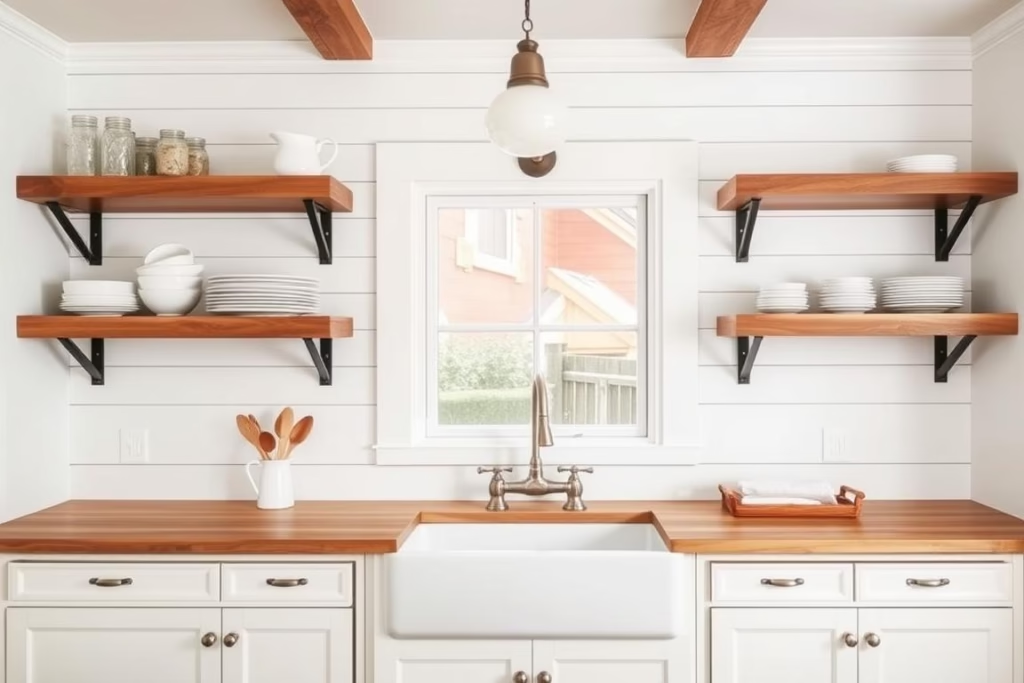
Architectural details create an authentic farmhouse foundationAdd Shiplap: This horizontal wood paneling instantly creates farmhouse character. Install it on an accent wall, kitchen island, or ceiling.Install Open Shelving: Replace upper cabinets with simple wooden shelves to display dishes and everyday items.Upgrade Your Sink: A classic apron-front (farmhouse) sink makes a significant impact in the kitchen.Consider a Barn Door: Where space allows, a sliding barn door adds both function and farmhouse flair.Expose Beams: If your home has ceiling beams, consider exposing them. If not, decorative beams can create a similar effect.
Mix Old and New
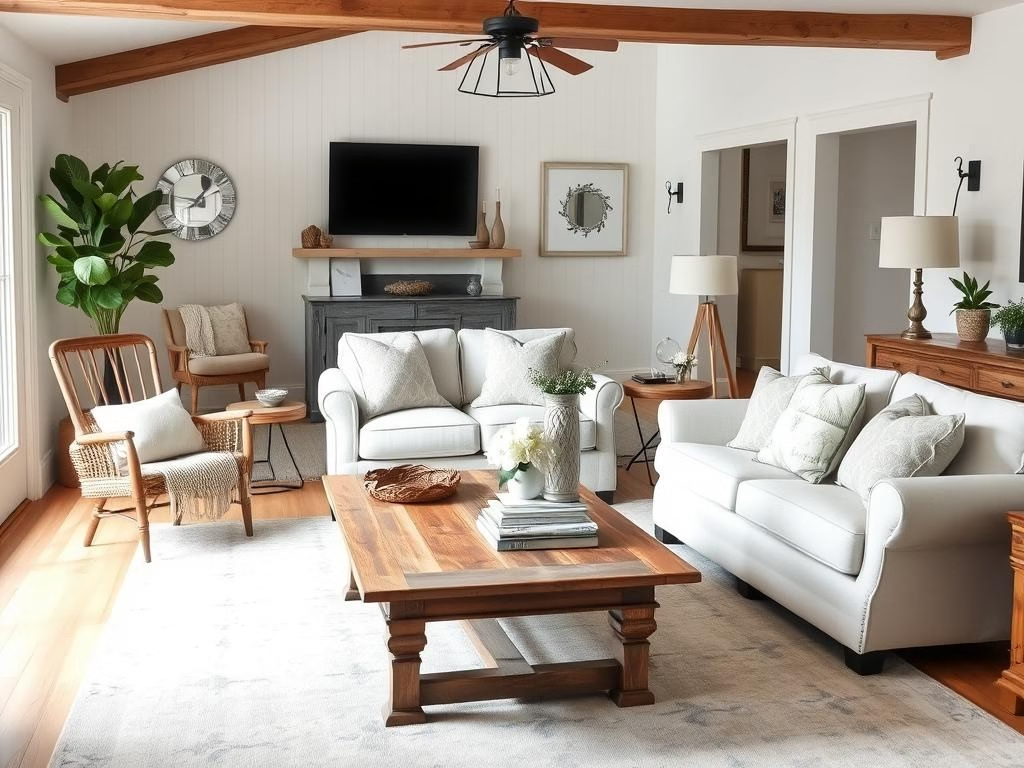
Blending vintage and contemporary pieces creates balanced farmhouse interiors
One of the secrets to successful farmhouse style is finding the right balance between old and new elements. This approach creates spaces that feel collected over time rather than purchased all at once.Pair a sleek sofa with a distressed wood coffee tableHang modern art in vintage framesCombine contemporary lighting with antique furnitureUse new upholstery on vintage chair framesBalance rustic architectural elements with clean-lined furnishings
Need more farmhouse inspiration?
Join our newsletter for monthly tips, DIY projects, and exclusive farmhouse style ideas!Email AddressSubscribe Now
DIY Projects to Try
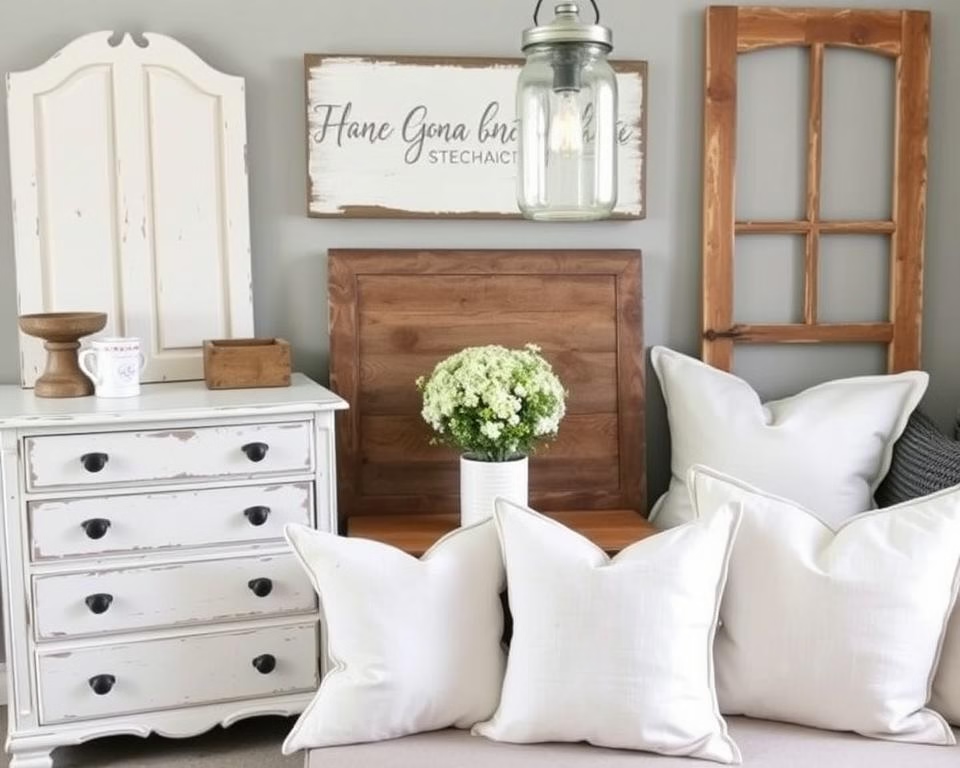
DIY projects add personal touches to your farmhouse style
Farmhouse style lends itself beautifully to DIY projects. These hands-on approaches not only save money but also add authentic character that can’t be purchased.
Furniture Transformations
Use chalk paint to give old furniture a new lifeDistress painted pieces for an aged appearanceReplace hardware with vintage-inspired knobs and pullsAdd wooden legs to upholstered pieces for farmhouse flair
Decor Projects
Create simple wooden signs with inspirational messagesMake mason jar light fixtures or candle holdersCraft no-sew drop cloth curtains or pillow coversRepurpose vintage items into functional decor
Why Farmhouse Style Remains Popular
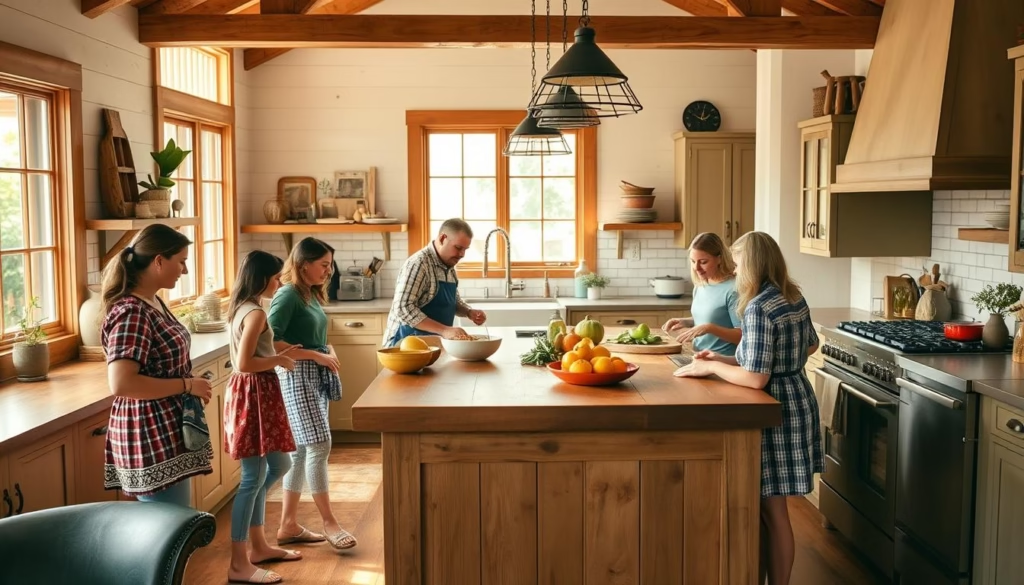
Farmhouse style creates spaces where people naturally want to gather
Despite design trends that come and go, farmhouse style has demonstrated remarkable staying power. Here’s why this aesthetic continues to resonate with so many homeowners:Comfort and Livability: Farmhouse style prioritizes comfort, creating spaces that invite you to relax and stay awhile.Timeless Appeal: By drawing on classic elements rather than fleeting trends, farmhouse style ages gracefully.Flexibility: The aesthetic can be adapted to various home styles, from actual farmhouses to urban apartments.Family-Friendly: Durable materials and practical design make farmhouse style ideal for households with children and pets.Connection to Simplicity: In our digital age, many people crave the authenticity and groundedness that farmhouse style represents.Accessibility: Elements of farmhouse style can be incorporated at various price points, making it attainable for many budgets.
Farmhouse Style in Action: Real-Life Examples
Let’s explore how farmhouse style comes to life in different spaces, showcasing the versatility and charm of this enduring aesthetic.
The Heart of the Home: Farmhouse Kitchens
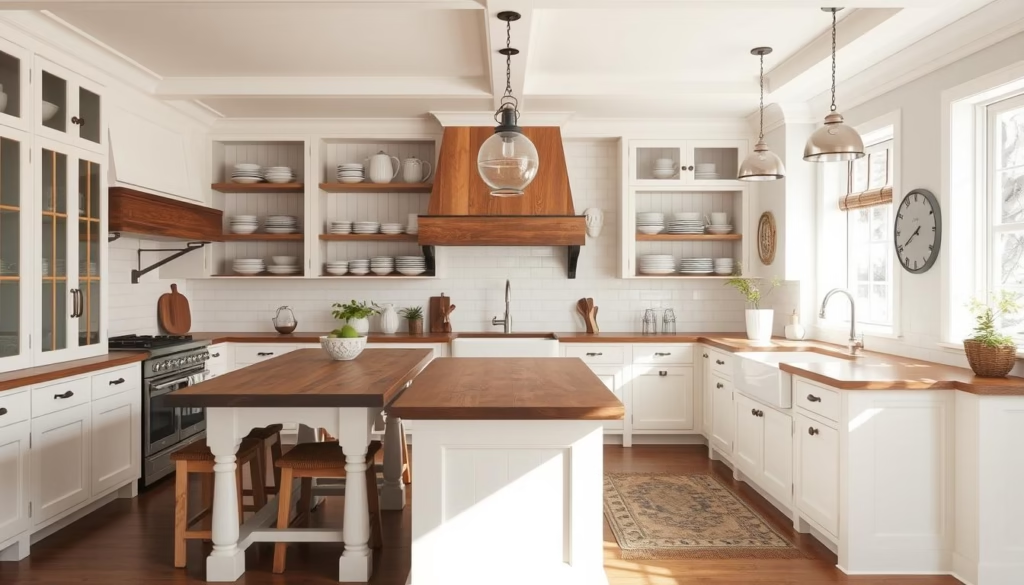
Farmhouse kitchens blend functionality with warm, inviting style
The kitchen is often where farmhouse style shines brightest, combining practical workspaces with comfortable gathering areas. Key elements typically include:Apron-front sinks (often white porcelain or fireclay)Open shelving displaying everyday dishesButcher block or marble countertopsShaker-style cabinetry in white or natural woodVintage-inspired hardware and fixturesA substantial island that serves as both workspace and gathering spot
Restful Retreats: Farmhouse Bedrooms

Farmhouse bedrooms emphasize simplicity and comfort
Farmhouse bedrooms create peaceful retreats through simplicity and layers of comfort. Common features include:Iron or wooden bed frames with simple linesLayered bedding with quilts, linen duvets, and textured throwsMinimal decor that focuses on quality over quantitySoft, muted color palettes that promote restVintage dressers or nightstands with characterSimple window treatments that allow natural light
Welcoming Entries: Farmhouse Porches
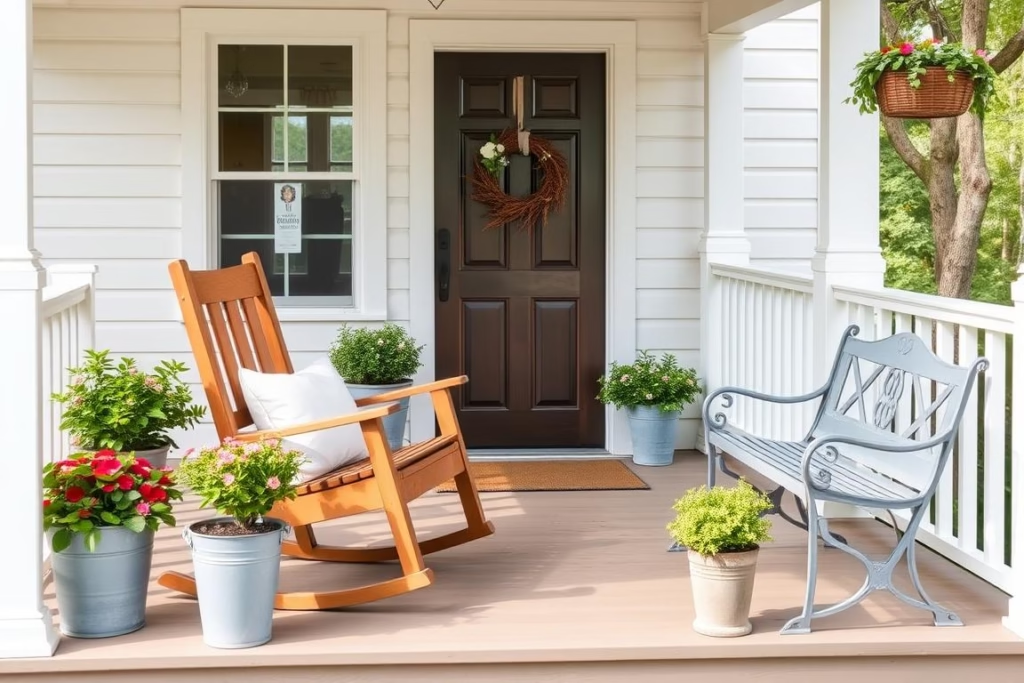
Farmhouse porches create welcoming transitions between outdoors and in
The farmhouse porch serves as a transition between outdoors and in, offering a welcoming space for relaxation and conversation. Key elements include:Comfortable seating like rocking chairs or porch swingsPotted plants in galvanized containers or terracotta potsVintage finds that can withstand outdoor exposureSimple outdoor textiles in weather-resistant fabricsLantern-style lighting for evening ambianceSeasonal wreaths or door decor that changes throughout the year
Frequently Asked Questions About Farmhouse Style
Can farmhouse style work in small spaces?
Absolutely! Farmhouse style can be particularly effective in small spaces because it emphasizes functionality and simplicity. For compact homes or apartments:Focus on a few key elements rather than trying to incorporate every farmhouse featureChoose light colors to maximize the sense of spaceSelect multi-functional furniture pieces that offer storageUse vertical space with wall-mounted shelving or hooksBe selective with decor to avoid a cluttered appearance
How can I avoid a cluttered farmhouse look?
While farmhouse style often incorporates collections and vintage finds, it shouldn’t feel cluttered. To maintain a clean, cohesive look:Edit your collections and display only your favorite piecesGroup similar items together rather than scattering them throughout a spaceIncorporate plenty of closed storage for items not on displayMaintain a consistent color palette to create visual harmonyRegularly reassess your decor and remove items that no longer serve your space
What are some budget-friendly farmhouse decor ideas?
Farmhouse style can be achieved on any budget. Here are some cost-effective approaches:Shop secondhand for authentic vintage pieces at thrift stores, flea markets, and yard salesRepurpose items you already own with paint or new hardwareDIY simple projects like drop cloth curtains or wooden signsUse natural elements like branches, pinecones, or dried herbs as free decorFocus on one room at a time rather than trying to transform your entire home at onceInvest in a few quality anchor pieces and supplement with budget-friendly accents
Is farmhouse style going out of fashion?
While specific trends within farmhouse style may evolve (like shiplap or barn doors), the core principles of farmhouse design—simplicity, functionality, and comfort—remain timeless. To create a farmhouse look with staying power:Focus on quality materials that age beautifullyAvoid overdoing trendy elements that might feel dated quicklyIncorporate pieces you truly love rather than following every trendBalance rustic elements with classic design for a more timeless approachAllow your farmhouse style to evolve naturally over time
Embracing Farmhouse Style in Your Home
Farmhouse style endures because it speaks to our desire for homes that are both beautiful and livable. By focusing on quality materials, thoughtful design, and personal touches, you can create spaces that feel both timeless and uniquely yours.
Remember that the most authentic farmhouse interiors evolve over time, incorporating elements that tell your family’s story. Whether you embrace full farmhouse style or simply incorporate a few favorite elements, the warmth and character of this aesthetic can transform your house into a place that truly feels like home.
Start Your Farmhouse Style Journey Today
Download our comprehensive guide with room-by-room farmhouse inspiration, shopping sources, and DIY project tutorials.Get Your Free Farmhouse Style Guide

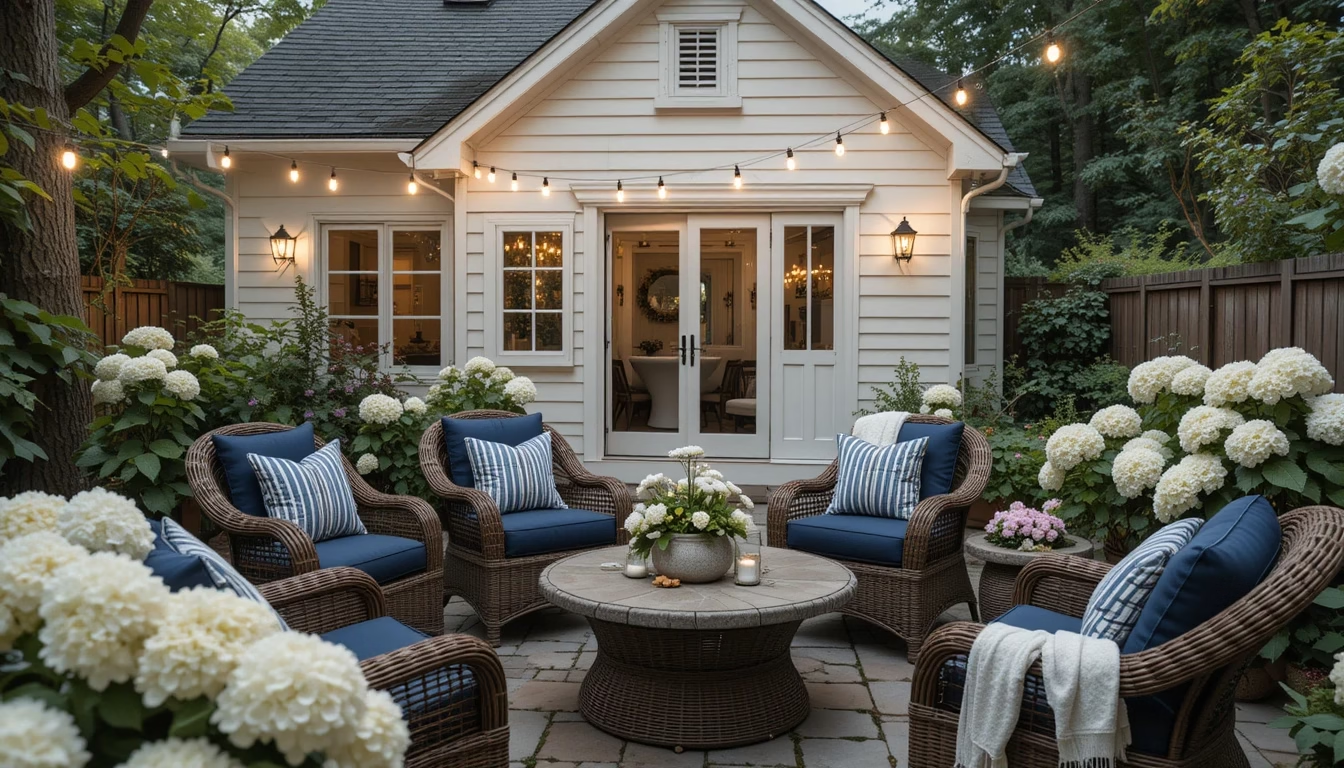
Leave a Reply